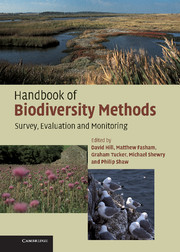Book contents
- Frontmatter
- Contents
- Preface
- Acknowledgements
- Part I Planning
- Part II Habitats
- Part III Species
- Appendix 1 Monitoring and reporting obligations under international conservation agreements
- Appendix 2 Relationship between BAP Priority Habitat and Broad Habitat categories and Habitats Directive nomenclature
- Appendix 3 Annotated list of key references for plant identification
- Appendix 4 Determining appropriate quadrat size for vegetation sampling
- Appendix 5 The relocation of permanent plots
- Appendix 6 Equipment required for undertaking different types of survey
- Recommended sources of further information
- References
- Glossary
- Index
Preface
Published online by Cambridge University Press: 01 September 2010
- Frontmatter
- Contents
- Preface
- Acknowledgements
- Part I Planning
- Part II Habitats
- Part III Species
- Appendix 1 Monitoring and reporting obligations under international conservation agreements
- Appendix 2 Relationship between BAP Priority Habitat and Broad Habitat categories and Habitats Directive nomenclature
- Appendix 3 Annotated list of key references for plant identification
- Appendix 4 Determining appropriate quadrat size for vegetation sampling
- Appendix 5 The relocation of permanent plots
- Appendix 6 Equipment required for undertaking different types of survey
- Recommended sources of further information
- References
- Glossary
- Index
Summary
This generation is living at a time when the world's biodiversity resources have never been so impoverished. If we take the UK as an example of what has happened across many parts of the planet, since 1945, largely as a result of agricultural intensification, we have lost over 50% of our ancient lowland woodlands, 150 000 miles of hedgerow, 95% of traditional hay meadows, 80% of chalk downland and 80% of wetland fens and mires. This has given rise to massive losses in some, once very common, farmland birds: in the past 30 years 40% of Song Thrushes, 54% of Yellowhammers, a staggering 87% of Starlings and 90% of Corn Buntings have disappeared.
In addition to agricultural intensification, development pressure as a result of industrialisation, human population expansion and resultant increases in the ‘ecological footprint’ of our own species through, for example, house building, airports, seaports, road infrastructure, water supply, energy generation, waste management, freight distribution and extraction of raw materials, has taken its toll on biodiversity. The UK government's sustainable development commission recently announced that the country has a very long way to go before existing developments, and the way we manage environmental resources, can be deemed to be ‘sustainable’. This is without any consideration of the impending threat from climate change.
But it would be wrong to focus entirely on the negatives.
- Type
- Chapter
- Information
- Handbook of Biodiversity MethodsSurvey, Evaluation and Monitoring, pp. xi - xiiPublisher: Cambridge University PressPrint publication year: 2005



